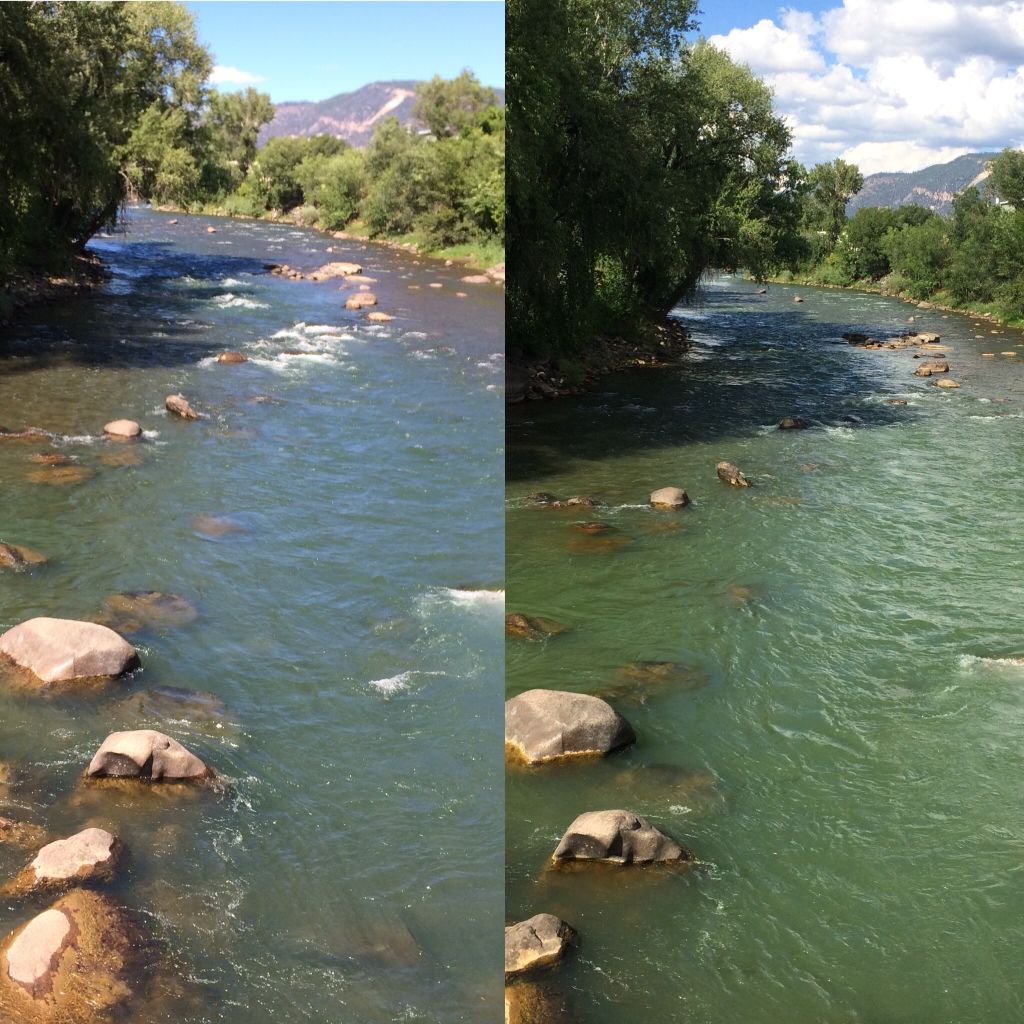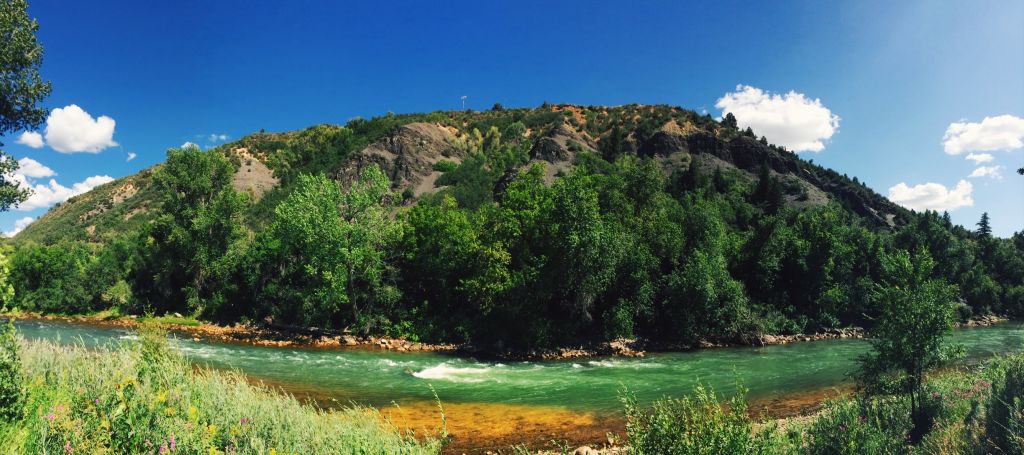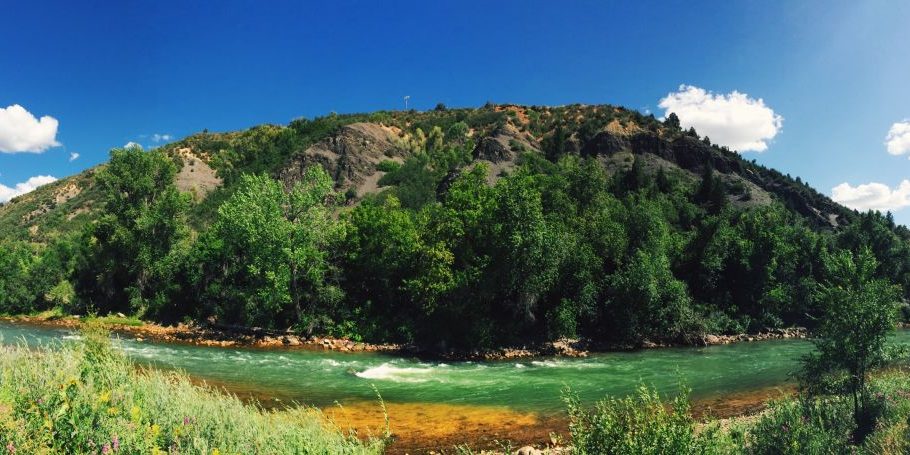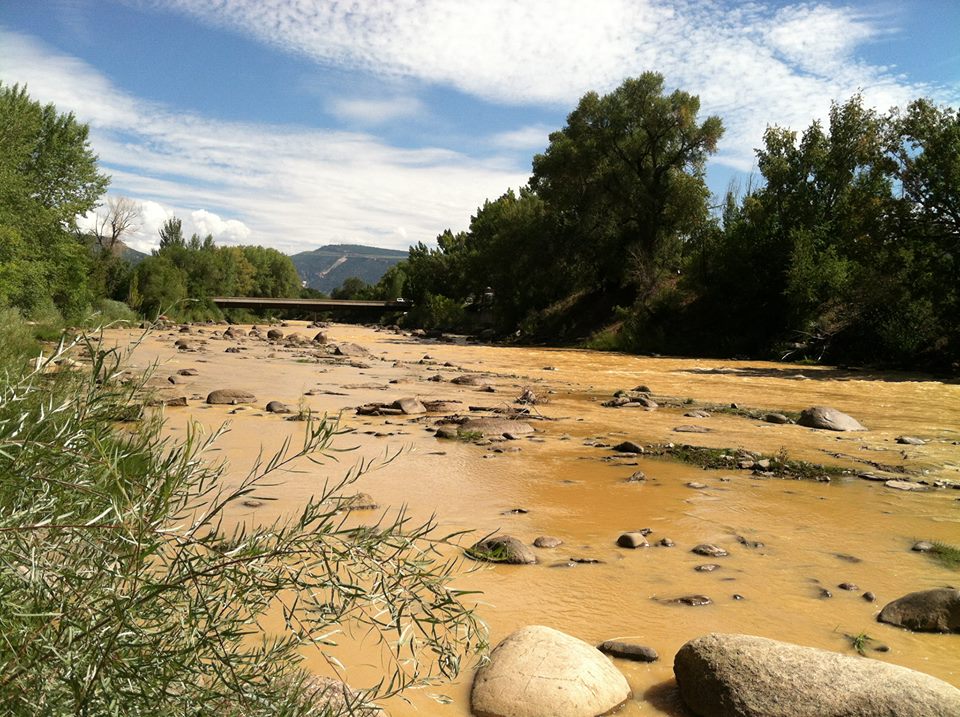Animas Lunch Report – 8/12/15 – Before and After – It’s Complex
So yesterday, we sent out a before and after photo of the Animas. For the most part, the response was very positive (we saw more shares of this post than any others in Duranglers history of using social media). But a few people didn’t respond so kindly to our statement. We wanted to repost it here on the Animas Lunch Report, along with another post from today. You can also see it here on Facebook.
 “The #animasriver is sick…but it’s not a new issue. The health of the upper Animas has always been a disaster.
“The #animasriver is sick…but it’s not a new issue. The health of the upper Animas has always been a disaster.
This river has not been a healthy River in over 100 years. This has been forgotten lately.
The photo on the left was taken hours before mine spill plume reached Durango. The photo on the right was taken 20 minutes ago. Roughly the same time of day. There is still a murky tinge to the water on the right, but it looks no different than if it had rained. Oh wait, it did rain last night. Did you know that every time it rains in#southwestcolorado, the zinc and cadmium levels go up 100% on the Animas?
Here is another fun fact, the pH and metal concentration levels have returned to roughly pre-spill levels. Don’t get us wrong, those levels are not great; but they have never been great. For years they have been declining.
If you don’t fish the Animas, then you may not know that the fish counts have been declining as well for the past 10 years. As anglers and guides who fish the Animas almost daily, we witness this first hand. Again, the Animas is sick…but it is not a new problem.
Thankfully, the trout the CPW put in the Animas as river “canaries” to see if they would die are all surviving (minus 1 out of 108, RIP little #soldier).
Insect life is also fairing very well. Thanks to the good work from#mountainstudiesinstitute who are providing this info.
“Well what about the long term effects? What about all those heavy metals deposited on the river bottom?” Well we have been living the long term effects since mining ceased in Silverton: struggling bug life and fish counts that have always walked a razor’s edge. And that junk that was deposited? That stuff has been getting deposited with spring runoff, rain storms, and landslides for the past 100 years.
The Animas is polluted. It’s not new.
Here is what matters: more people are caring about the Animas River health than ever before. Hopefully this will lead to long lasting change.
Also, when both of these photos were taken, we were watching trout eat emergers just below the surface.
#realtalk #bethechange #flyfishing #duranglers #durango #logic #micdrop#savetheanimas #troutbum”
And here is our follow up post:
“So our previous post seems to ruffled a few feathers. We stand by our statement that our river is sick, and has been sick for a very long time now. It needs to be fixed. It needs help. And no, we don’t think the EPA deserves a free pass on this one…yet we can’t fully fault them for trying to fix an ongoing issue either.
You may have seen the nasty photos of the #animasriver on CNN from the mine spill in Silverton last week. It looked horrible. For some perspective,we wanted to re-share this above photo. It was taken August 30th, 2013.
For a lot of us, the orange nasty color of the Animas was shocking…but not entirely new. Thanks to hardrock mining in SW Colorado, we are treated with that same color from time to time. Usually after a good, refreshing rain.
Here is to fixing the problem at it’s root cause. #savetheanimas”
It seems that the Animas having been a polluted river was news to some. It is our home river, it is a beautiful river, but it is a sick river. We want to be honest about the Animas so that we can see these longstanding issues fixed!
We are also seeing a fair amount of news come through the pipe that is encouraging. These are quick summaries, click on the link for the full article.
Animas River test trout did not die and were removed from the river to be studied. Included in that study will be what trace heavy metals and toxins will be present in these fishes bodies.
Stoneflies, Caddis, and Mayflies are still present in the Animas and bug life is thriving. (A quick note, stoneflies cannot live in a fully toxic environment and are usually the first to disappear. Stoneflies are present in the Animas, but in small numbers. This has been the case for many years.)
Animas is back to pre-spill pH and toxin levels in Durango.
The statement from the EPA cheif Gina McCarthy.
And you should read this article from the Daily Kos that basically summarizes everything.
If all goes well, the Animas may be open again for public use August 17th.
This is the current state of the Animas, only time will tell the long term effects: good or bad. While we have seen heavy metal sediment settled in slower flows of the river, we have also seen fish eating bugs and none of them are showing the tell tale signs of being dead (floating upside down with the current). We do also know a handful of sneaky anglers have been getting out on the river and catching fish, wet wading we might add.
And if you were able to fish the Animas River today, hoppers are out in full force.

While all is looking good for now, you can still see the heavy metal sediment left in this eddy from the plume that swept through the Animas and Durango. For a Durango local, we have seen this before. Only time will tell what the long term effects will be. Hopefully it is action taken to fix the Animas and making it better than it has been in 100 years.










Thank you for the updates. This should be a major national story.
Thanks guys…I was here for the ’78 dump when the lake collapsed…much worse than this! 500 million gallons of grey sludge.
As a retired fishery biologist, whenever I hear “heavy metals” in the water with salmonids, I get a little wary about the situation. I was raised around Durango and love the Animas, so anything that has the potential to damage the river further get to me a little. I am not worried about the short-term effects of this spill, as it moved through relatively quickly. Heavy metal toxicity tends to be a long-term thing, though, so sub-lethal exposures may yet have some deleterious influences on the river fauna, over time ( there is an excellent paper on the internet reviewing the effects of sub-lethal exposures of seven heavy metals on fish). The areas of the river that were on the “tipping point” with respect to the effects of heavy metals on fish near the upper end of the Animas may be tipped with this new exposure, so the affected zone may well move down into lower reaches of he stream. I am very hopeful that the relatively short exposure to this plume will have minimal effects on the fauna of the river.
Hey Clayton,
Thank you for your input. We are always glad to hear outside opinions (and expert opinions) on this matter. We are certainly hoping for the best but the long term effects have yet to be seen.
Our hope is that one long term effect is that hardrock mining pollution of Colorado’s yesteryear is brought to the forefront of people’s minds and that going forward, these problem sites can be handled before something like this happens again.
Thank you very much and take care!
-Andy